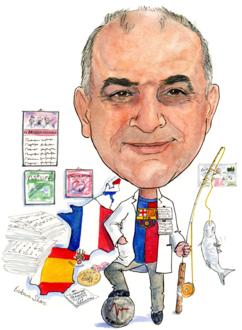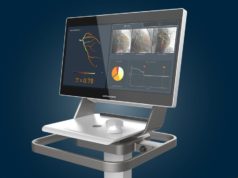
Josep Brugada, medical director, Hospital Clínic, Barcelona, Spain, and his brothers, Pedro and Ramon, all developed a passion for cardiology. Together, they indentified Brugada Syndrome. Josep Brugada spoke to Cardiovascular News about his career, his proudest moments and the Futbol Club Barcelona, “the team with the best players in the world”
Your family has a tradition in medicine. How did it influence you?
The tradition in medicine in my family is rather new; it started with my oldest brother Pedro, but never before, and continued with myself and Ramon, my youngest brother. The three of us are cardiologists. Now, it continues with Georgia, who is the daughter of our beloved sister Dolors, and she is a paediatric cardiologist. We have tried to work together as much as possible, to help each other and to put all our efforts in the same direction to achieve common objectives. So far I guess we are doing quite well.
Why did you decide to specialise in cardiology and electrophysiology?
As I explained, Pedro started this business in the family and because of his very strong influence and success I continued in the same direction. We suggested Ramon, the youngest one, to specialise in cardiology but specifically in genetics because we thought this was an area that would develop in the next years and he listened to our recommendation. Now with Georgia we have covered another field by introducing paediatric cardiology into the family. I think we are all complementary and, by promoting collaboration among us, I am sure we can achieve much greater results.
Who have been your greatest influences?
Basically, my greatest influence has come from my parents. My father was an incredibly hard worker, very proud of his family and an extremely pleasant person, who loved social gatherings. My mother is still alive and is the centre of our family. She decided almost everything. She understood that education was at the basis of progress and, despite the fact our family was rather modest, she decided that all of us would move to Barcelona from our little town of Banyoles, to get a university degree.
How has electrophysiology evolved since you began your career?
At the beginning of my career, electrophysiology was a descriptive subspeciality, we probably were the intellectuals in cardiology, but also the ones that cured nothing. We spent hours and hours analysing very complex tracings, we described a lot of mechanisms and hypothesised a lot, but we had almost nothing to offer to our patients. Suddenly, everything changed. ICDs on one side and radiofrequency ablation on the other put us in the centre of technological development. We started to cure patients, and at the same time we became very interesting for industry. Now, the reality is that electrophysiology is very well recognised, the protocols and guidelines are clear and based in well-established scientific evidence. In the upcoming years, more and more technological developments will help us improve the results even more.
You and your brothers described Brugada Syndrome, an inheritable arrhythmia syndrome, in 1992. How has investigation and treatment changed since then?
Initially, the description was based on clinical observation. We saw some patients with a defined profile and we put them together. We believed at that moment that these were some exceptional cases. Very soon we realised that this could represent a much more important description when we saw that many centres around the world started identifying more and more patients. Publications about the syndrome multiplied and in every big meeting, several sessions were devoted to the syndrome. This generated an incredible amount of information about, not only Brugada Syndrome, but all channel diseases and genetically determined diseases. Information continues to grow and we are far from having all answers to the many questions still open.
What have been your proudest moments?
Professionally speaking I have many moments of pride. When I received a PhD at the age of 28; when I received the first prize in the Young Investigator Award Competition of ACC in 1991; when my institution, Hospital Clínic offered me the possibility to come back to Barcelona and start the Arrhythmia Unit; when I became chief of cardiology; when I became professor of medicine at University of Barcelona and more recently, when I became medical director of Hospital Clínic in Barcelona. Scientifically, I am very proud of the first paper I published in Circulation and of course of the recognition of Brugada Syndrome by the international community. But I recognise as very special moments in my life when Pedro became professor, when Ramon published the first description of a locus for atrial fibrillation in the New England Journal of Medicine and when the three of us co-authored with others the paper in Nature describing the genetic nature of Brugada Syndrome.
How far do you think it is possible to go with regard to advances to antiarrhythmic drugs?
Antiarrhythmic drugs are not in the best moment of their history. Devices and invasive techniques have expanded so much that drugs seem to have been forgotten. We have probably been looking at pharmacological effects in a single way, one of the channels and basic electrophysiological properties like refractoriness and conduction velocity. However, probably is now the time to rethink the type and effects of drugs and to look at it from another, more molecular view. Maybe this will help in the development of different drugs, with different effects and aiming at other targets in the heart.
In your opinion, what recent catheter ablation technology will have the greatest impact in the field?
Catheter ablation has done tremendous work in the last 25 years. We have cured almost all types of tachycardias, with a rather low complication rate. Now we move to more complex substrates like ventricular tachycardia or atrial fibrillation and the success rates and complication rate are different. New technology has to improve these issues and has to harmonise the way the procedures are done.
There are too many variations from centre to centre in terms of success and complications. If we want a technique like catheter ablation to be socially relevant, it has to be used by many electrophysiologists in many centres. Atrial fibrillation is so prevalent that only with simple, easy and saving techniques, we will have the opportunity to solve it, as has happened for instance with the Wolff-Parkinson-White Syndrome.
You developed your career in Spain and in The Netherlands. What differences you see in the electrophysiology practice in the two countries?
I had the chance to work in three different countries: Spain, France and The Netherlands. In all three, the level of electrophysiology is extremely high. Of course there are some differences concerning the healthcare model. In France the model is more open to the individual practice; in The Netherlands the procedures are more controlled and performed only in specific and well defined centres; and in Spain we have a public, universal health system with the limitations of such model in terms of waiting lists or lack of investment in new centres. But, as I said, the scientific level is extremely high and with very well-prepared professionals.
What are your current areas of research?
At present my group continues to be very interested in sudden death mechanisms, including the collaboration with Pedro and Ramon in channelopathies. Personally, I continue to perform a lot of paediatric electrophysiology and, with my niece Georgia, we work on new techniques for ablation in neonates and children. In Clínic we have a very strong group working in epicardial ablation, all kinds of ventricular tachycardia and atrial fibrillation ablation and in the study of imaging techniques to visualise electrical pathways in the heart. Also, together with the imaging department and cardiac insufficiency unit we have a large programme on resynchronisation therapy.
Outside of medicine, what other interests do you have?
Every year in July I travel for a week to Northern countries (Iceland, Norway, Russia, Alaska, etc) to perform my favourite hobby: salmon fly fishing. I have been doing this with some friends for many years and it is like a big decompression. After that, I am ready for the next year. My second big hobby is soccer. I am a fan of Futbol Club Barcelona, the team with the best players in the world: Messi, Xavi, Iniesta, Puyol, etc, and an incredible trainer: Guardiola. I am very proud because, since last year, I am the co-ordinator of the cardiology assistance of Futbol Club Barcelona players. And in FC Barcelona this means taking care of 1,700 players, because there is a tremendous soccer school that takes care of young talents of all ages.
Fact File
Positions
Present status Medical director, Hospital Clínic de Barcelona, Spain
Head of the Arrythmia Unit St Joan De Déu Pediatric Hospital, Barcelona, Spain
Professor of Medicine, University of Barcelona, Spain
Head of the Arrythmia Unit St Jordi Cardiovascular Center, Barcelona, Spain
Education
1982 Honours degree in Medicine and Surgery, University of Barcelona, Madrid, Spain
1987 Medical doctor in Medicine and Surgery, University of Barcelona, Madrid, “Cum Laude”
1989 Cardiologist, University of Montpellier I, France
1988 Specialist in Biology and Sports Medicine, University of Montpellier I, France
University appointments
1988–1989 Assistant professor, Department of Physiology, University of Limburg, Maastricht,
The Netherlands
1990–1991 Associate professor of Physiology, Universitat de Limburg, Maastricht, The Netherlands
1997–2008 Associate professor of Medicine, University of Barcelona, Spain
2009–Present Professor of Medicine, University of Barcelona, Spain
Scientific societies
President of the European Heart Rhythm Association (2007–2009)
Past vice-chairman of the Spanish Society of Cardiology
Fellow of the European Society of Cardiology
International fellow of the Postgraduate School of Rhythmology, Aalst, Belgium
Member of: Catalan Society of Cardiology, Spanish Society of Cardiology, European Society of Cardiology, European Heart Rhythm Association, North American Society of Pacing and Electrophysiology (NASPE), Workshop in Rhythmology (ESC)
Member of the editorial boards of the Spanish Society of Cardiology Journal and of Cardiovascular Drugs and Therapy (Clinical Pharmacology and Drug Studies section)
Member of the Advisory Council of North American Society of Pacing and Electrophysiology
Member of the Research Fellowship and Training Fellowship Committee (ESC)
Deputy editor of the European Heart Journal
Reviewer: Spanish Society of Cardiology Journal, PACE, European Heart Journal, Journal of the American College of Cardiology, Circulation, Journal of Cardiovascular Electrophysiology, Europace













